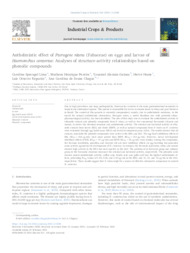Anthelmintic effect of Pterogyne nitens (Fabaceae) on eggs and larvae of Haemonchus contortus: analyses of structure-activity relationships based on phenolic compounds.
Anthelmintic effect of Pterogyne nitens (Fabaceae) on eggs and larvae of Haemonchus contortus: analyses of structure-activity relationships based on phenolic compounds.
Author(s): LIMA, C. S.; PEREIRA, M. H.; ALEMÁN GAINZA, Y.; HOSTE, H.; REGASINI, L. O.; CHAGAS, A. C. de S.
Summary: Due to high prevalence and large pathogenicity, Haemonchus contortus is the main gastrointestinal nematode in tropical and subtropical regions. This species is responsible for severe economic losses to sheep and goat breeders in Brazil. The control of this parasite is currently compromised, mainly, due to anthelmintic resistance. In the search for natural anthelmintic alternatives, Pterogyne nitens, a native Brazilian tree with potential ethnopharmacological activity, has been identified. The aim of this study was to evaluate the anthelmintic activity of ethanolic extracts and phenolic compounds from P. nitens, as well as two commercial flavonoids (chrysin and morin), to derive the chemical structure and anthelmintic activity. The ovicidal and larvicidal activity of ethanolic extracts from leaves (EEL) and fruits (EEFR), as well as natural compounds from P. nitens on H. contortus were evaluated through egg hatch assay (EHA) and larval development assay (LDA). The results showed that all extracts, especially the phenolic compounds were active in the EHA and LDA. The egg hatch inhibitory effects of EEL (EC50 = 316 μg/mL) were more potent than EEFR (EC50 = 512 μg/mL). However, larval development inhibitory effects of EEL (EC50 = 47 μg/mL) and EEFR (EC50 = 35 μg/mL) were similar. Among the compounds, the flavones (sorbifolin, pedalitin, and chrysin) did not have inhibitory effects on egg hatching but presented some activity against larval development of H. contortus. In contrast, the flavonols (quercetin, rutin, and morin) showed high activity in the EHA but were inactive in the LDA. The addition of at hydroxyl group and rutinose group to the flavonoid structure increased the ovicidal and larvicidal activity, respectively. The phenolic acids showed potent anthelmintic activity: caffeic acid, ferulic acid, and gallic acid had the highest anthelmintic effects, presenting EC50 values of 1.48, 0.56, and 4.93 μg/mL in the EHA; and 31, 22, and 33 μg/mL in the LDA, respectively. These results suggest that P. nitens might be a source of effective alternative compounds to control H. contortus.
Publication year: 2021
Types of publication: Journal article
Observation
Some of Embrapa's publications are published as ePub files. To read them, use or download one of the following free software options to your computer or mobile device. Android: Google Play Books; IOS: iBooks; Windows and Linux: Calibre.
Access other publications
Access the Agricultural Research Database (BDPA) to consult Embrapa's full library collection and records.
Visit Embrapa Bookstore to purchase books and other publications sold by Embrapa.

